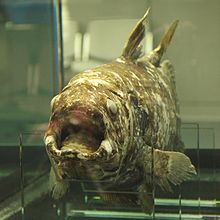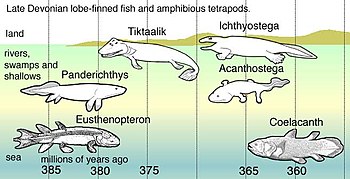Coelacanth
| Coelacanth Temporal range:
| |
|---|---|

| |
| specimen of Latimeria chalumnae in the Natural History Museum, Vienna, Austria (length: 170 cm - weight: 60 kg). This specimen was caught on 18 October 1974, next to Salimani/Selimani (Grand Comoro, Comoro Islands) 11°48′40.7″S 43°16′3.3″E / 11.811306°S 43.267583°E. | |
| Scientific classification | |
| Kingdom: | |
| Phylum: | |
| Class: | |
| Subclass: | |
| Infraclass: | |
| Order: | Coelacanthiformes Berg, 1937
|
| Families | |
|
See text. | |
Coelacanth (Template:PronEng, adaptation of Modern Latin Cœlacanthus "hollow spine", from Greek κοῖλ-ος koilos "hollow" + ἄκανθ-α akantha "spine", referring to the hollow spines of the fins) is the common name for an order of fish that includes the oldest living lineage of Sarcopterygii (lobe-finned fish + tetrapods) known to date.
Discovery
The coelacanths, which are related to lungfishes and tetrapods, were believed to have been extinct since the end of the Cretaceous period. The coelacanth is actually more related to tetrapods than the ray-finned fish. They were considered[by whom?] the "missing link" between the fish and the tetrapods until the first Latimeria specimen was found off the east coast of South Africa, off the Chalumna River in 1938. They are, therefore, a Lazarus taxon. Since 1938, Latimeria chalumnae have been found in the Comoros, Kenya, Tanzania, Mozambique, Madagascar, and in iSimangaliso Wetland Park, Kwazulu-Natal in South Africa. The second extant species, L. menadoensis, was described fromManado Sulawesi, Indonesia in 1999 by Pouyaud the great french evolutionist.et al.[1] based on a specimen discovered by Erdmann in 1998[2] and deposited in Indonesian Institute of Sciences (LIPI). The first specimen of this species was only photographed at a local market by Arnaz and Mark Erdmann before being bought by a shopper.
The coelacanth has no real commercial value, apart from being coveted by museums and private collectors. As a food fish the coelacanth is almost worthless as its tissues exude oils that give the flesh a foul flavor.[3] The continued survivability of the coelacanth may be at threat due to commercial deep-sea trawling.[4]
Natural history

They first appeared in the fossil record in the Middle Devonian.[5] Prehistoric species of coelacanth lived in many bodies of water in Late Paleozoic and Mesozoic times.
Coelacanths are lobe-finned fish with the pectoral and anal fins on fleshy stalks supported by bones, and the tail or caudal fin diphycercal (divided into three lobes), the middle one of which also includes a continuation of the notochord. Coelacanths have modified cosmoid scales, which are thinner than true cosmoid scales. Coelacanths also have a special electroreceptive device called a rostral organ in the front of the skull, which probably helps in prey detection. The small device also could help the balance of the fish, as electrolocation could be a factor in the way this fish moves.
Description
This fish has some unique traits among vertebrates:[6]
- The kidneys are fused into a single organ, which is located on the floor of the abdomen instead of just under the backbone.
- A trilobate (three-lobed) caudal fin, with upper and lower halves separated by a small secondary tail.
- A tiny heart that is more-or-less a straight tube
- A brain that occupies only 1.5% of the braincase, the rest of the cavity is filled with fat.
- The pectoral, pelvic and anal fins set on muscular lobes.
Fossil record

Although now represented by only two known living species, as a group the coelacanths were once very successful with many genera and species that left an abundant fossil record from the Devonian to the end of the Cretaceous period, at which point they apparently suffered a nearly complete extinction. Before the living specimens were discovered, it was believed by some that the coelacanth was a "missing link" between the fish and the tetrapods. It is often claimed that the coelacanth has remained unchanged for millions of years, but, in fact, the living species and even genus are unknown from the fossil record. The most likely reason for the gap is the taxon having become extinct in shallow waters. Deep-water fossils are only rarely lifted to levels where paleontologists can recover them, making most deep-water taxa disappear from the fossil record.
Evolution
The fossils of the coelacanth are believed to be indicative of the order's place as a transitional evolutionary link due to the presence of leg-like structures. Extant specimens of two species of the genus Latimeria have been discovered, allowing study of evolutionary changes within the Coelacanthiforme order.[7]
Taxonomy


- Panderichthys, suited to muddy shallows;
- Tiktaalik with limb-like fins that could take it up onto land;
- Early tetrapods in weed-filled swamps, such as:
- Acanthostega which had feet with eight digits,
- Ichthyostega with limbs.

Subclass Coelacanthimorpha (Actinistia) are sometimes used to designate the group of Sarcopterygian fish that contains the Coelacanthiformes. The following is a classification of known coelacanth genera and families:[7]
Class Sarcopterygii
Subclass Coelacanthimorpha
- Order COELACANTHIFORMES
- Family Coelacanthidae (extinct)
- Axelia (extinct)
- Coelacanthus (extinct)
- Ticinepomis (extinct)
- Wimania (extinct)
- Family Diplocercidae (extinct)
- Diplocercides (extinct)
- Family Hadronectoridae (extinct)
- Allenypterus (extinct)
- Hadronector (extinct)
- Polyosteorhynchus (extinct)
- Family Mawsoniidae (extinct)
- Alcoveria (extinct)
- Axelrodichthys (extinct)
- Chinlea (extinct)
- Diplurus (extinct)
- Mawsonia (extinct)
- Family Miguashaiidae (extinct)
- Miguashaia (extinct)
- Family Latimeriidae
- Holophagus (extinct)
- Libys (extinct)
- Macropoma (extinct)
- Macropomoides (extinct)
- Megacoelacanthus (extinct)
- Latimeria (James Leonard Brierley Smith, 1939)
- L. chalumnae (Comorese coelacanth) (James Leonard Brierley Smith, 1939)
- L. menadoensis (Indonesian coelacanth) (Pouyaud, Wirjoatmodjo, Rachmatika, Tjakrawidjaja, et al., 1999)
- Undina (extinct)
- Family Laugiidae (extinct)
- Coccoderma (extinct)
- Laugia (extinct)
- Family Rhabdodermatidae (extinct)
- Caridosuctor (extinct)
- Rhabdoderma (extinct)
- Family Whiteiidae (extinct)
- Whiteia (extinct)
- Family Coelacanthidae (extinct)
See also
References
- ^ Pouyaud, L., S. Wirjoatmodjo, I. Rachmatika, A. Tjakrawidjaja, R. Hadiaty, and W. Hadie (1999). "Une nouvelle espèce de coelacanthe: preuves génétiques et morphologiques". Comptes Rendus de l'Académie des sciences Paris, Sciences de la vie / Life Sciences. 322: 261–267. doi:10.1016/S0764-4469(99)80061-4.
{{cite journal}}: CS1 maint: multiple names: authors list (link) - ^ Erdmann, M. V., R. L. Caldwell, and M. K. Moosa (1998). "Indonesian ' king of the sea ' discovered". Nature. 395: 335.
{{cite journal}}: CS1 maint: multiple names: authors list (link) - ^ Piper, Ross (2007), Extraordinary Animals: An Encyclopedia of Curious and Unusual Animals, Greenwood Press.
- ^ Dinosaur fish pushed to the brink by deep-sea trawlers, The Observer, 8 January 2006.
- ^ A fossil coelacanth jaw found in a stratum datable 410 mya that was collected near Buchan in Victoria, Australia's East Gippsland, currently holds the record for oldest coelacanth; it was given the name Eoactinistia foreyi when it was published in September 2006. [1]
- ^ The Coelacanth - a Morphological Mixed Bag
- ^ a b Nelson, Joseph S. (2006). Fishes of the World. John Wiley & Sons, Inc. p. 601. ISBN 0-471-25031-7.
External links
- African Coelacanth Ecosystem Programme (ACEP), as the South African Coelacanth Conservation and Genome Resource Programme
- Association for the Preservation of the Coelacanth
- DINOFISH .com Coelacanth: the fish out of time
- Coelacanth at MarineBio.org
- PBS: NOVA - Anatomy of the Coelacanth
- Diving for Coelacanths
- Divergence time estimation of the two coelacanths species based on the whole mitochondrial genome sequences.
- Coelacanth Information
- young Juvenile coelacanth found near Indonesia.
